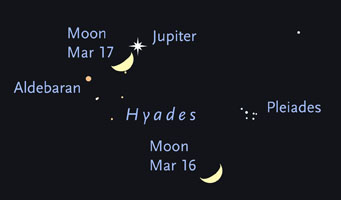This will be a month of transition. First, the U.S. and Canada will change to Daylight or Summer time on March 10th ( but the switch occurs but three weeks later across Europe). Also, on March 20th at 7:02 a.m. Eastern Daylight Time, Earth reaches one of the two equinox points in its year-long orbit.

The Moon slides between Jupiter and Aldebaran in mid-March 2013.
Sky & Telesope diagram
Look for Jupiter high in the southwest — it’s about 2/3 of the way up on March 1st and half way up by month’s end. The bright star to Jupiter’s lower left is Aldebaran, and on the 17th, a fat crescent Moon slides right between them.
As darkness deepens turn toward south and you’ll find the first star of the evening: brilliant Sirius, the Dog Star. Sirius is the brightest star in the entire sky by a large margin (aside from our own Sun, of course).
Between Jupiter and Sirius, you’ll easily see the stars of Orion, the Hunter, striding up from the eastern horizon. Look in particular for a trio of bright stars in a vertical row. These mark Orion’s belt.
This month also features a chance to see Comet Pan-STARRS with your unaided eye. To find out where and when to look for it, download March's 6-minute-long audio sky tour.
 0
0
Comments
You must be logged in to post a comment.